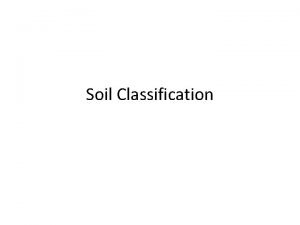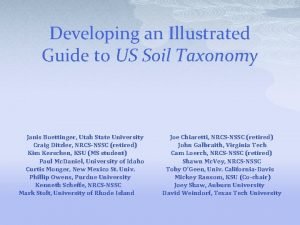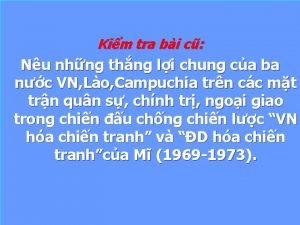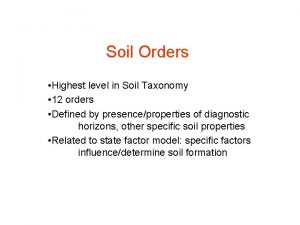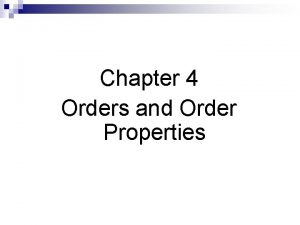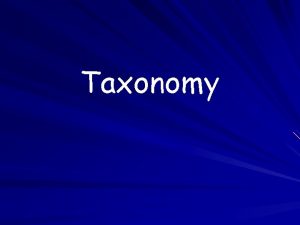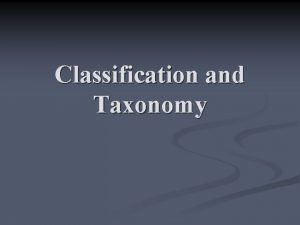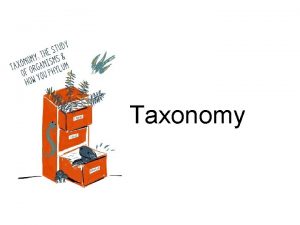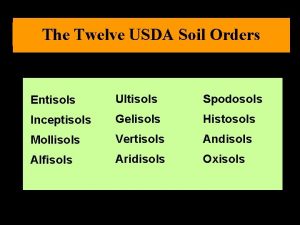Soil Taxonomy The Twelve Soil Orders In 1975















- Slides: 15


Soil Taxonomy • The Twelve Soil Orders • In 1975, Soil Taxonomy was published by the United States Department of Agriculture's Soil Survey Staff. This system for classifying soils has undergone numerous changes since that time, and the 2 nd edition was published in 1999. Soil Taxonomy remains one of the most widely used soil classification systems in the world. • At the highest level, Soil Taxonomy places soils in one of 12 categories known as orders. We have put together a collection of information and images to illustrate the distribution, properties, ecological significance, and use of these 12 soil orders.

Gelisols • (from Latin gelare, "to freeze") are soils of very cold climates that contain permafrost within 2 meters of the surface. • These soils are limited geographically to the highlatitude polar regions and localized areas at high mountain elevations. • Because of the extreme environment in which they are found, Gelisols support only ~0. 4% of the world's population - the lowest percentage of any of the soil orders.

Histosols • (from Greek histos, "tissue") are soils that are composed mainly of organic materials. • They contain at least 20 -30% organic matter by weight and are more than 40 cm thick. • Bulk densities are quite low, often less than 0. 3 g cm 3.

Spodosols • (from Greek spodos, "wood ash") are acid soils characterized by a subsurface accumulation of humus that is complexed with Al and Fe. • These photogenic soils typically form in coarsetextured parent material and have a light-colored E horizon overlying a reddish-brown spodic horizon. • The process that forms these horizons is known as podzolization.

Andisols • (from Japanese ando, "black soil") are soils that have formed in volcanic ash or other volcanic ejecta. • They differ from those of other orders in that they typically are dominated by glass and short-range-order colloidal weathering products such as allophane, imogolite, and ferrihydrite. • As a result, Andisols have andic properties - unique chemical and physical properties that include high water-holding capacity and the ability to 'fix' (and make unavailable to plants) large quantities of phosphorus.

Oxisols • (from French oxide, "oxide") are very highly weathered soils that are found primarily in the intertropical regions of the world. • These soils contain few weatherable minerals and are often rich in Fe and Al oxide minerals. Oxisols occupy ~7. 5% of the global ice-free land area. In the US, they only occupy ~0. 02% of the land area and are restricted to Hawaii.

Vertisols • (from Latin verto, "turn") are clay-rich soils that shrink and swell with changes in moisture content. During dry periods, the soil volume shrinks, and deep wide cracks form. • The soil volume then expands as it wets up. This shrink/swell action creates serious engineering problems and generally prevents formation of distinct, well-developed horizons in these soils. • Globally, Vertisols occupy ~2. 4% of the ice-free land area. In the US, they ccupy ~2. 0% of the land area and occur primarily in Texas.

Aridisols • (from Latin aridus, "dry") are Ca. CO 3 -containing soils of arid regions that exhibit at least some subsurface horizon development. • They are characterized by being dry most of the year and limited leaching. Aridisols contain subsurface horizons in which clays, calcium carbonate, silica, salts, and/or gypsum have accumulated. • Materials such as soluble salts, gypsum, and Ca. CO 3 tend to be leached from soils of moister climates. Aridisols occupy ~12% of the Earth's ice-free land area and ~8. 3% of the US.

Ultisols • (from Latin ultimus, "last") are strongly leached, acid forest soils with relatively low native fertility. • They are found primarily in humid temperate and tropical areas of the world, typically on older, stable landscapes. • Intense weathering of primary minerals has occurred, and much Ca, Mg, and K has been leached from these soils. • Ultisols have a subsurface horizon in which clays have accumulated, often with strong yellowish or reddish colors resulting from the presence of Fe oxides. The 'red clay' soils of the southeastern United States are examples of Ultisols. • Ultisols occupy ~8. 1% of the global ice-free land area and support 18% of the world's population. They are the dominant soils of much of the southeastern US and occupy ~9. 2% of the total US land area.

Mollisols • (from Latin mollis, "soft") are the soils of grassland ecosystems. They are characterized by a thick, dark surface horizon. This fertile surface horizon, known as a mollic epipedon, results from the long-term addition of organic materials derived from plant roots. Mollisols primarily occur in the middle latitudes and are extensive in prairie regions such as the Great Plains of the US. Globally, they occupy ~7. 0% of the ice-free land area. In the US, they are the most extensive soil order, accounting for ~21. 5% of the land area. Mollisols are among some of the most important and productive agricultural soils in the world and are extensively used for this purpose.

Alfisols • are moderately leached soils that have relatively high native fertility. These soils have mainly formed under forest and have a subsurface horizon in which clays have accumulated. Alfisols are primarily found in temperate humid and subhumid regions of the world. Alfisols occupy ~10. 1% of the global ice-free land area. In the US, they account for ~13. 9% of the land area. Alfisols support about 17% of the world's population. The combination of generally favorable climate and high native fertility allows Alfisols to be very productive soils for both agricultural and silvicultural use.

Inceptisols • (from Latin inceptum, "beginning") are soils that exhibit minimal horizon development. They are more developed than Entisols, but still lack the features that are characteristic of other soil orders. Although not found under aridic climate regimes, Inceptisols nevertheless are widely distributed and occur across a wide range of ecological settings. • They are often found on fairly steep slopes, young geomorphic surfaces, and on resistant parent materials. Land use varies considerably with Inceptisols. A sizable percentage of Inceptisols are found in mountainous areas and are used forestry, recreation, and watershed.

This document is 100% funded by a $2. 2 million grant from the U. S. Department of Labor, Employment and Training Administration (TAACCCT). The product was created by the grantee and does not necessarily reflect the official position of the U. S. Department of Labor. The Department of Labor makes no guarantees, warranties or assurances of any kind, express or implied, with respect to such information, including any information on linked sites and including, but not limited to, accuracy of the information or its completeness, timeliness, usefulness, adequacy, continued availability, or ownership. This work is licensed under a Creative Commons Attribution 4. 0 International License.

Entisols • are soils of recent origin. The central concept is soils developed in unconsolidated parent material with usually no genetic horizons except an A horizon. All soils that do not fit into one of the other 11 orders are Entisols. Thus, they are characterized by great diversity, both in environmental setting and land use. Many Entisols are found in steep, rocky settings. However, Entisols of large river valleys and associated shore deposits provide cropland habitat for millions of people worldwide. Globally Entisols are the most extensive of the soil orders, occupying ~18% of the Earth's ice-free land area. In the US, Entisols occupy ~12. 3% of the land area.
 Twelve twins twirled twelve twigs
Twelve twins twirled twelve twigs Casey orders 3 pizzas and 2 orders of breadsticks
Casey orders 3 pizzas and 2 orders of breadsticks Casey orders 3 pizzas and 2 orders of breadsticks
Casey orders 3 pizzas and 2 orders of breadsticks Casey orders 3 pizzas
Casey orders 3 pizzas Kendall taxonomy
Kendall taxonomy Elluviation
Elluviation What is soil
What is soil Illustrated guide to soil taxonomy
Illustrated guide to soil taxonomy Living soil vs dead soil
Living soil vs dead soil Living soil vs dead soil
Living soil vs dead soil Xuân 1975
Xuân 1975 Contoh rumus slovin
Contoh rumus slovin Gouvernance économique mondiale depuis 1975
Gouvernance économique mondiale depuis 1975 Palette de tony cragg
Palette de tony cragg 1975-1959
1975-1959 Since 1975
Since 1975






